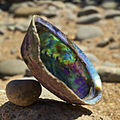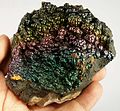Iriseren
Iriseren (også kaldet irisering, (perlemorsagtigt) farvespil, regnbueglans og perlemorsglans) er en farve, som skifter farve alt afhængig af, hvilken vinkel den ses fra. Iriseren forekommer naturligt, men kan også skabes kunstigt. Iriseren ses flere eksempelvis på sæbebobler, CD'er og spildt benzin. Kan også ses på fjer, muslinger, insekter, maling, slanger, fisk, sten, skyer og planter (sjældent). Iris kommer af det græske ord ἶρις (îris), som betyder regnbue.
Galleri
- (c) Jörg Hempel, CC BY-SA 3.0 de
Iriseren på en musling.
- (c) Rob Lavinsky, iRocks.com – CC-BY-SA-3.0
Iriseren på goethit.
Iriseren på bismuth.
Iriseren på en CD.
Eksterne henvisninger
Medier brugt på denne side
Forfatter/Opretter:
|
Female Golden Stag Beetle, Lamprima aurata. Taken in Victoria, Australia in Jan 2009
Forfatter/Opretter: unknown, Licens: CC BY-SA 3.0
Forfatter/Opretter: User Black and White on en.wikipedia, Licens: CC BY-SA 3.0
This image depicts a flat view of a CD-R with interference colours. It was scanned with an HP ScanJet 4400c, and ran through ACDSee's auto-level filter. One fallback of the image are the dust fibres. It was initially saved as .JPG with IrfanView at 90% quality, and then converted to .PNG to add transparency.
Forfatter/Opretter: Robin Corps from Crowthorne, England, Licens: CC BY-SA 2.0
An awesome paint job on a Toyota Supra.
Forfatter/Opretter: Alexcooper1, Licens: CC BY-SA 3.0
One of two photos that demonstrate the iridescence in peacock feathers
Forfatter/Opretter: Didier Descouens, Licens: CC BY-SA 4.0
Dorsal view of male butterfly which was captured in Peru and is stored in Muséum de Toulouse.
Forfatter/Opretter: Damien Farrell, Licens: CC BY 3.0
Rainbow Boa. E. c. gaigei. Taken in Peruvian rain forest.
This Chrysididae on a goldenrod was identified as Hedychrum rutilans (Dahlbom, 1854) thanks to Christian Schmid-Egger (HymIS.de).
Location: Boeldershoek, Hengelo (Overijssel), Netherlands
Keywords: Iridescence, parasite
---
nl: Goudwesp van de soort Hedychrum rutilans op een guldenroede op braakliggend terrein (ruigte)
Locatie: Industrieterrein Boeldershoek, Hengelo (Overijssel), Nederland
Trefwoorden: Iriseren, goudwesp, parasiet
---
de: Goldwespe der Art Hedychrum rutilans auf eine Goldenrute auf brachliegendes Grundstück
Forfatter/Opretter: Alchemist-hp (talk) (www.pse-mendelejew.de), Licens: FAL
The chemical element bismuth as a synthetic made crystal. The iridescent surface is a very thin layer of oxidation. Beside it is a high purity (99.99 %) 1 cm3 bismuth cube for comparison.
(c) Jörg Hempel, CC BY-SA 3.0 de
Shell of a Paua snail (Haliotis iris), Oamaru, New Zealand
Veil-tail con qualche leggera caratteristica Crown-tail
(c) Rob Lavinsky, iRocks.com – CC-BY-SA-3.0
Goethite
- Locality: Coon Creek Mine (York Mine), Shady, Polk County, Arkansas, USA (Locality at mindat.org)
- Size: 8.5 x 7.5 x 3.0 cm.
- An amazing Arkansas goethite specimen from the Coon Creek Mine. This beautifully iridescent and colorful goethite has botryoidal goethite in parallel bands of black, yellow-green, pink, purple and blue-green. The goethite is on novaculite. Ex. A.L. Kidwell Collection and a note on his label has a 1976 date.






























